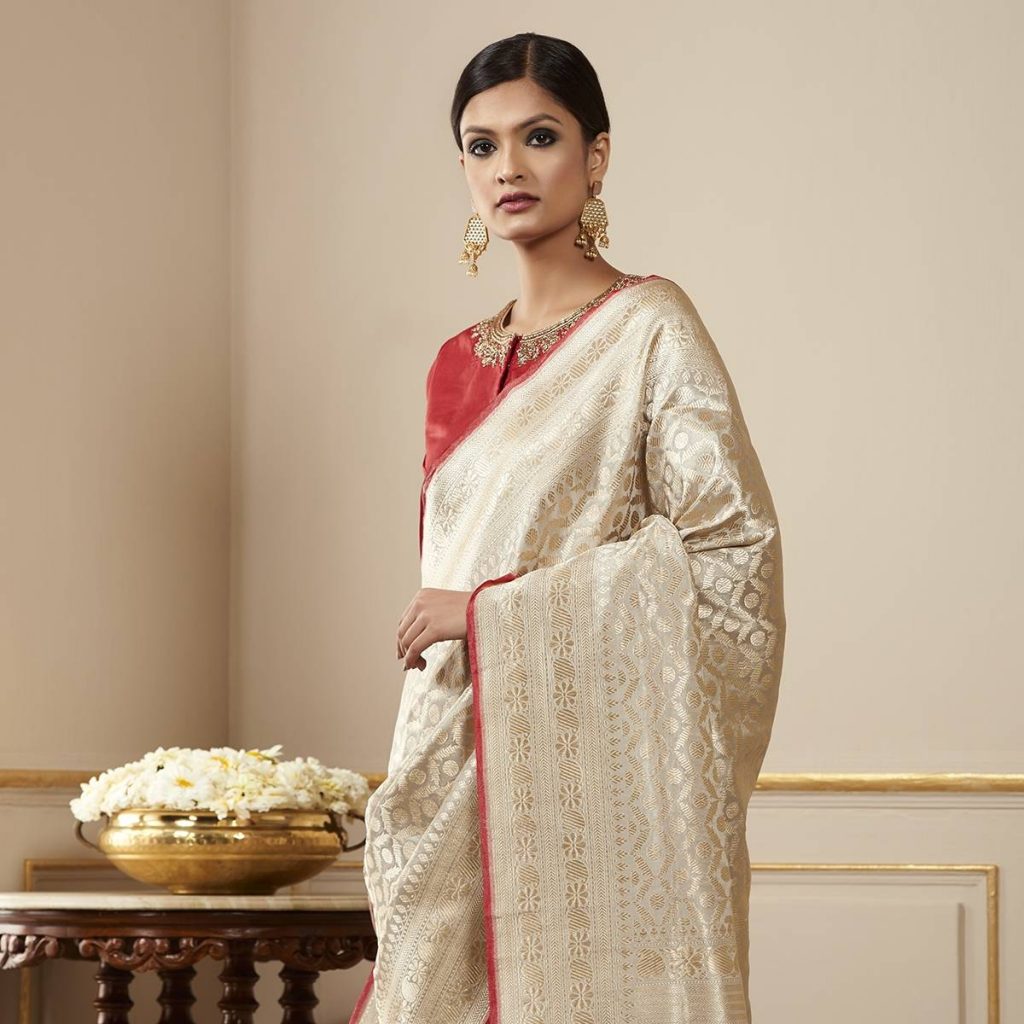
When contemporizing a craft there is always a fine line between expanding a craft’s vocabulary and disrespecting a tradition…writes Sujata.
Tamil Nadu’s famed kanjivaram textile technique dates back to the time of the Chola period. Chola kings are said to have invited Padmasaliya weavers from neighbouring kingdoms to the temple town of Kanchipuram to weave silk.
Traditionally a Kanjivaram sari is made of Native Indian Mulberry silk, they were occasion saris, the body of the drape would be plain, striped or patterned. Real zari would add a feel of decadence to its palau and borders–what made this vibrant sari famous was its colour play. Over the years the kanjivaram has adapted to keep its relevance–for example since the kanjivaram predates the advent of the jacquard loom by a few centuries, the brocade style kanjivarams that are today considered bridal beauties could actually be called a design intervention of the 20th century.

As K.H. Radharaman, creative director of Advaya, a label that prides itself on its craft savoir faire, says,”Textiles are a document of living culture.” Advaya is the label of Bangalore based design house, House of Angadi, and Radharaman’s family have been in the textile industry for 600 years. With this lineage he sees himself as a custodian of the craft. “I am a traditionalist at heart, and I revere tradition. My family has been involved in the creation of the very pieces that are revered as classics in the genres that I have worked in. I have personally revived and recreated many old designs and have regenerated many old techniques.” Yet he is also the man behind the linen kanjivaram. “I would also argue that innovation is necessary to contemporize craft,” he adds.

It was Advaya that was behind Deepika Padukone’s custom made wedding sari in 2018. While this was the first time most fashion folk heard of Radharaman’s work, those in textiles have been aware of his weaves for well over a decade. It was 11 years ago that he created the first linen kanjivaram. Says Radharaman,”I had worked on linen for the international market as far back as 2006 and I realised that the matte appearance of linen would blend in beautifully and seamlessly with the subtle gold hue of the Kanjivaram zari.”
Read More-Actress Dia Mirza shares wedding snaps
It took 15 months of work for this intervention to come alive and since then many sari designers have turned to linen. Available by order and in limited editions linen kanjivarams are now seen as collector’s items by many sari connoisseurs. However there are some conservative textile historians who look at experimentations with disdain.
This has not stopped the label’s founder to stay on path of intervention, being a trained engineer and not a design graduate is perhaps why he is not bound by any rules. Radharaman has since worked on several other “updates” including the khadi and tussar kanjivarams. These saris speak of traditions from different parts of India and different times, the country’s history can be woven together.

When contemporizing a craft there is always a fine line between expanding a craft’s vocabulary and disrespecting a tradition. “My work as a textile designer is diverse and straddles a wide array of techniques, tools, materials, and craft clusters. I believe all of this has helped me contemporize the design language of traditional Indian crafts in a significant way — making it relevant to the present and future generations.” At his retail store, Angadi, traditional and innovative weaves by Advaya sit next to each other–an untrained eye may not be able to tell which saris are interventions, since the architecture of the saris remain loyal to traditions.
Also Read-Sanjay Garg: Other is what lies within
By working with lighter forms of cloth, and not sticking to the prescribed silks, Radharaman has added a very modern and user-friendly appeal feel to the kanjivaram’s repertoire. Advaya is currently working on a new line of bridal saris that alter the visual design vocabulary and motifs of a Kanjivaram sari. He says,”Now with the help of technological breakthroughs and immense investments at the back end we have managed to create large scale repeats and render beautiful, almost story-like motifs that derive inspiration from diverse subjects.”

For Radharaman innovations like this keep the sari relevant and exciting to future generations. But he notes a sari must never be trend driven–being timeless and heirloom worth are properties of the sari that are non-negotiable. Which would explain why this textile innovator views adding a sartorial element would be blasphemy. “The sari is a finished product and is not yardage that needs to be cut and stitched. Suggesting that a finished product needs to be repurposed or enhanced is akin to saying that a work of art, a true masterpiece needs an additional stroke of paint.”
The writer Sujata Assomull is a columnist. Assomull is the author “100 Iconic Bollywood Costumes” and was the Founding Editor In Chief of Harper’s Bazaar, India.
Also Read-FALGUNI NAYAR: Smart in a Saree
Read More-‘Saree in a Gadi’ for Women Empowerment


